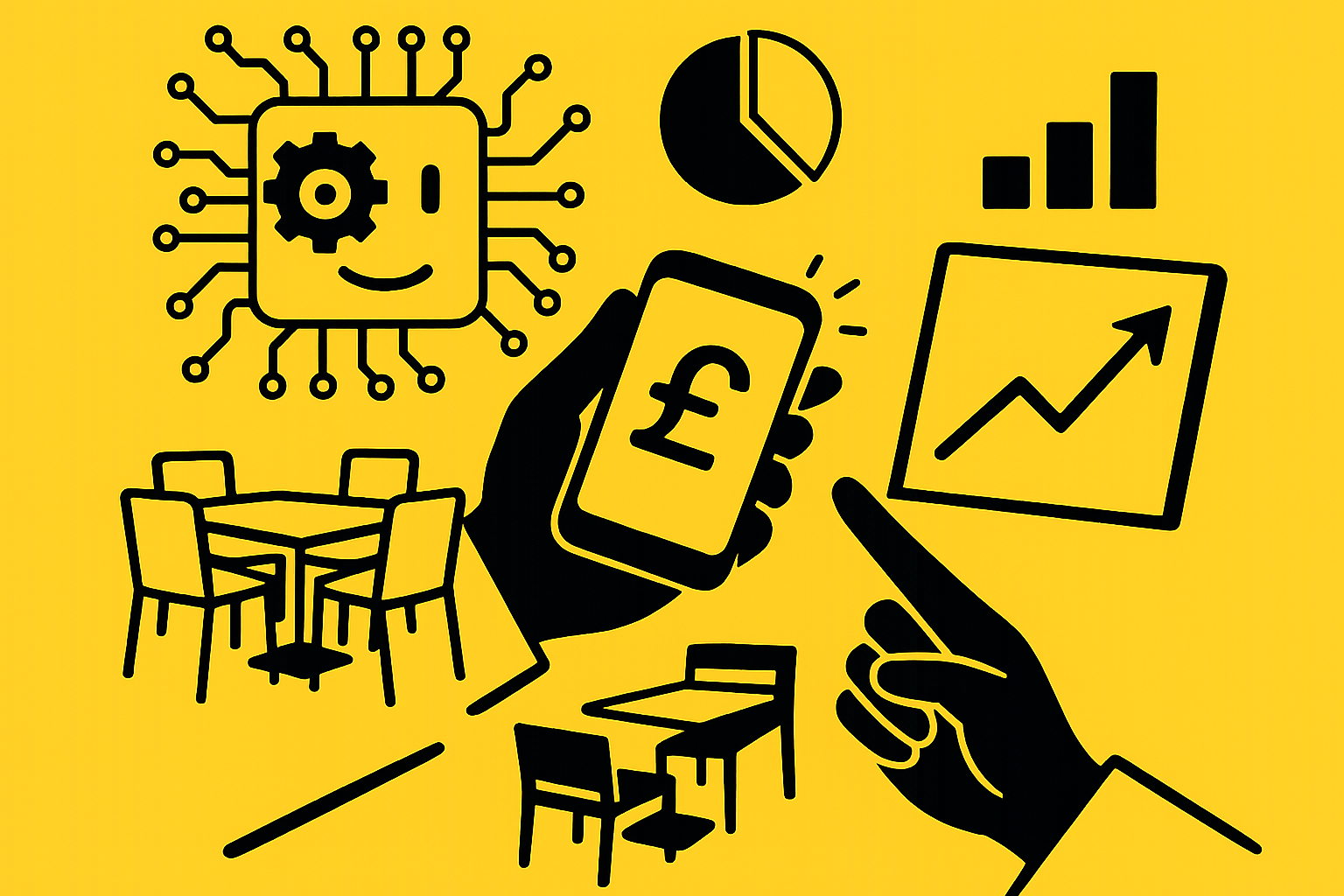
For restaurant operators managing a 100-seat establishment, every missed call represents lost revenue. High-volume restaurants receive between 800 and 1,000 calls per month, which can disrupt service and overwhelm staff (2025 Buyer's Guide: Best AI Restaurant Software). The question isn't whether AI reservation systems work—it's whether the numbers make sense for your specific operation.
Modern AI solutions are generating an additional revenue of $3,000 to $18,000 per month per location, up to 25 times the cost of the AI host itself (Q3 2025 Restaurant Tech Trends). But what does this mean in real dollars for a typical 100-seat restaurant handling 900 calls monthly?
This comprehensive breakdown uses the latest industry data to provide concrete cost projections, revenue recovery calculations, and payback period analysis across three pricing tiers. Whether you're evaluating your first AI system or comparing providers, these numbers will help you make an informed decision.
Before diving into AI costs, let's establish what you're losing without automated phone management. Restaurant phone lines are a significant source of revenue generation, with every missed call representing lost reservations, takeout orders, and potential customer relationships (2025 Restaurant Voice Assistant Comparison).
For our analysis, we're using a typical 100-seat restaurant with these characteristics:
With 900 monthly calls and a conservative 15% miss rate during peak periods (roughly 40% of total calls), you're missing approximately 54 calls monthly. If just 30% of these would have resulted in reservations:
This baseline helps justify AI investment costs and provides a clear ROI framework.
Based on current market analysis, AI restaurant software platforms typically offer three pricing structures. According to Popmenu's 2024 study of 362 U.S. restaurant operators, 79% have implemented or are considering AI for various operations including taking orders, preparing food, business operations, and marketing (Popmenu AI in Restaurants Report).
Setup Costs:
Monthly Recurring Costs:
Features Included:
Setup Costs:
Monthly Recurring Costs:
Features Included:
Setup Costs:
Monthly Recurring Costs:
Features Included:
AI reservation systems don't just handle calls—they free up your existing staff for higher-value activities. Low pay, high stress, worker competition, and reluctance from those laid off during the pandemic to return, on top of poor working conditions have led to a chronic shortage of entry-level staff in Canada's hospitality industry (Forbes: How AI is Transforming Restaurants).
A typical 100-seat restaurant dedicates significant host/hostess time to phone management:
| Tier | Monthly Labor Savings | Annual Labor Savings |
|---|---|---|
| Basic AI | $1,200-1,500 | $14,400-18,000 |
| Advanced AI | $1,800-2,200 | $21,600-26,400 |
| Enterprise AI | $2,000-2,500 | $24,000-30,000 |
These savings reflect the percentage of phone-related tasks each AI tier can handle autonomously, allowing staff to focus on in-person guest service.
The primary value proposition of AI reservation systems lies in capturing previously missed revenue opportunities. AI voice assistants are transforming how restaurants handle customer communications, with three platforms dominating the landscape in 2025: Hostie AI, Slang AI, and Maple Voice (2025 Restaurant Voice Assistant Comparison).
Basic AI System:
Advanced AI System:
Enterprise AI System:
Beyond missed call recovery, AI systems generate revenue through:
Upselling and Cross-selling:
Extended Operating Hours:
AI hosts are generating an additional revenue of $3,000 to $18,000 per month per location, up to 25 times the cost of the AI host itself (Forbes: How AI is Transforming Restaurants).
Let's examine the complete financial picture for each tier over a 12-month period.
Total Investment (Year 1):
Total Benefits (Year 1):
Net ROI: $42,190 (509% return)
Payback Period: 1.97 months
Total Investment (Year 1):
Total Benefits (Year 1):
Net ROI: $59,898 (456% return)
Payback Period: 2.15 months
Total Investment (Year 1):
Total Benefits (Year 1):
Net ROI: $70,778 (328% return)
Payback Period: 2.8 months
The global food automation market is projected to reach $14 billion by the end of 2024 (Q3 2025 Restaurant Tech Trends). This rapid growth means implementation processes are becoming more streamlined.
Week 1-2: Setup and Configuration
Week 3: Staff Training
Week 4: Soft Launch
Month 2: Full Deployment
Newo.ai allows restaurants to create their AI host in one click within minutes. The system can handle reservations directly and can be implemented in under an hour by feeding it the restaurant's menu, signature dishes, and reservation schedules (Forbes: How AI is Transforming Restaurants).
Menu Accuracy: Ensure your AI system has current pricing, availability, and dietary information.
Integration Quality: Seamless connection with your existing reservation and POS systems prevents double-bookings and data inconsistencies.
Staff Buy-in: Train your team to work alongside AI, not against it. Contrary to fears of job displacement, many restaurants find that AI hosts complement human staff (Forbes: How AI is Transforming Restaurants).
Ongoing Optimization: Regular performance reviews and system updates ensure continued ROI improvement.
Key players in the AI restaurant software market as of 2025 include Hostie AI, Slang AI, Maple Voice, and various open-source alternatives (2025 Buyer's Guide: Best AI Restaurant Software).
HostieAI is designed for restaurants, made by restaurants (Introducing Hostie). The platform offers an automated guest management system that learns and engages with nuance, integrating directly with existing reservation systems, POS systems, and even event planning software (Introducing Hostie).
Key Advantages:
Conversation Quality: Test the AI's ability to handle complex requests, modifications, and edge cases.
Integration Capabilities: Ensure compatibility with your current reservation, POS, and management systems.
Scalability: Choose a system that can grow with your business, whether you're planning expansion or seasonal fluctuations.
Support Quality: Evaluate the provider's training, onboarding, and ongoing support offerings.
Pricing Transparency: Look for clear, predictable pricing without hidden fees or surprise overages.
There is a potential 69% increase in AI and robotics use in fast food restaurants by 2027 (Q3 2025 Restaurant Tech Trends). This rapid adoption is driving both innovation and cost optimization across the industry.
Better Natural Language Processing: Improved AI understanding reduces the need for complex menu programming and frequent updates.
Cloud Infrastructure Optimization: More efficient hosting and processing reduce per-minute charges and improve reliability.
Integration Standardization: Common APIs and protocols make setup faster and less expensive.
As more providers enter the market, competition is driving:
AI systems must comply with:
These compliance costs are typically built into provider pricing but should be verified during evaluation.
With clear cost projections and ROI calculations, the decision framework becomes straightforward:
Cash Flow Analysis:
Revenue Opportunity Assessment:
Operational Readiness:
Start Small: Begin with a basic tier and upgrade as you see results and understand your needs better.
Pilot Period: Negotiate a trial period or money-back guarantee to test system performance in your specific environment.
Gradual Rollout: Implement during slower periods to work out any issues before peak seasons.
Staff Communication: Clearly communicate the AI's role as a complement to, not replacement for, human staff.
Technology has never been more accessible for businesses of any size. In just a couple of years, there will hardly be any business that hasn't hired an AI employee (Forbes: How AI is Transforming Restaurants).
Predictive Analytics: Future systems will predict busy periods and adjust staffing recommendations accordingly.
Advanced Personalization: AI will remember individual guest preferences across multiple visits and channels.
Integrated Marketing: Reservation systems will connect with email marketing and social media for comprehensive guest engagement.
Voice Commerce: Direct ordering and payment processing through voice interactions.
When evaluating providers, prioritize:
For a 100-seat restaurant handling 900 calls monthly, AI reservation systems deliver compelling ROI across all pricing tiers. With payback periods under 3 months and annual returns exceeding 300%, the question isn't whether to invest—it's which tier best matches your current needs and growth plans.
The data shows that even basic AI systems recover their costs quickly through missed call recovery and labor savings. Advanced and enterprise tiers offer additional revenue streams through upselling, extended hours, and enhanced guest experiences that justify their higher costs.
In multicultural cities like Toronto and Montreal, AI systems offer a distinct advantage with their multilingual capabilities, enabling smoother communication with diverse clientele and enhancing the overall customer experience (Forbes: How AI is Transforming Restaurants).
As the restaurant industry continues evolving, AI reservation systems represent not just a cost-saving measure, but a competitive advantage that enhances both operational efficiency and guest satisfaction. The investment pays for itself quickly, and the ongoing benefits compound over time.
Restaurants are rapidly becoming the last bastion of personal interaction in the retail space, but that doesn't mean technology can't enhance these interactions (Forbes: How AI is Transforming Restaurants). The right AI reservation system amplifies your hospitality rather than replacing it.
💡 Ready to see Hostie in action?
Don't miss another reservation or guest call.
👉 Book a demo with Hostie today
AI reservation systems for 100-seat restaurants range from $200-800 per month depending on features and call volume. Basic systems start around $200/month, mid-tier solutions cost $400-500/month, while enterprise systems can reach $800+/month. The investment typically pays for itself within 3-6 months through increased bookings and reduced labor costs.
According to 2025 industry data, modern AI solutions are generating an additional revenue of $3,000 to $18,000 per month per location, up to 25 times the cost of the AI host itself. High-volume restaurants that receive 800-1,000 calls monthly see the highest returns, as AI systems capture previously missed reservations and optimize table turnover.
The primary costs include monthly software licensing ($200-800), initial setup and integration fees ($500-2,000), staff training ($200-500), and ongoing support. Additional costs may include phone system integration, POS connectivity, and customization for specific restaurant needs. Most providers offer tiered pricing based on call volume and feature requirements.
Most 100-seat restaurants achieve positive ROI within 3-6 months of implementation. The payback period depends on call volume, current reservation capture rate, and average ticket size. Restaurants with high phone volumes and frequent missed calls typically see faster returns, often recovering their investment within 2-3 months through increased bookings alone.
Key factors include monthly call volume (basic tier handles 200-500 calls, enterprise handles 1,000+), integration requirements with existing POS and reservation systems, multilingual support needs, and advanced features like predictive analytics. Restaurants should also consider scalability, as growing businesses may need to upgrade tiers as call volume increases.
According to Forbes coverage on restaurant AI transformation, artificial intelligence is revolutionizing multiple aspects of restaurant operations including demand forecasting, personalized customer interactions, inventory management, and staff optimization. AI systems now handle complex tasks that previously required human intelligence, from managing waitlists to creating targeted marketing campaigns, making restaurants more efficient and profitable.
RELATED


